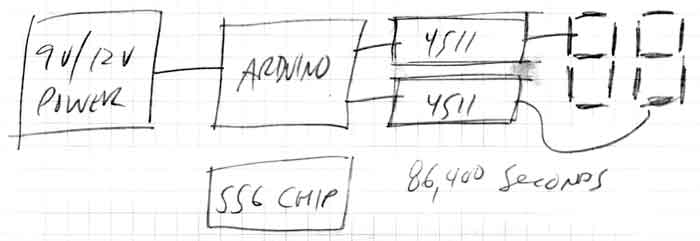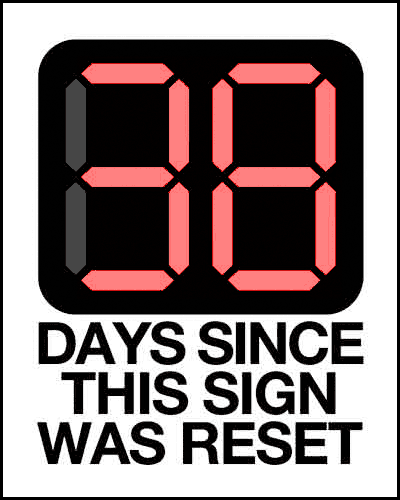xkcd's version |
my version |
So I have my design all figured out, now I need the important part of this project:
The Brains....Brains...Brains!
I realize that using an Arduino is overkill. But I needed (a minimum of) 14 digital outputs and a lousy daily timer, and if I buy some of the cheapest Arduino clones you can get, we can lower our costs to an affordable level. Since this sign should automatically step up by 1 number every 24 hours, it's a boring job, and someone has to do it, why not overkill it with an Arduino?
Parts, Suppliers and Costs
| Part | Supplier | Cost |
|---|---|---|
| Arduino | RBBB Kit from Modern Device | $12.50 |
| Power | 9V Power Adapter | $9.00 |
| Base | 24×36 Black Foamcore from any Art Supply Store | $4.79 |
| Frame | $20 | |
| Lights | 100 White LED's From DealExtreme | $10.50 |
Light Emitting Diodes - Counting the Multipliers
Since there's a variable in power draw, depending on how many days it's been, and what number it's displaying. For example, all 14 bars are illuminated with the number 88, only 4 bars lit with the number 11. Depending on how many LED's we use to illuminate each bar, we can be talking about the difference between illuminating 12 and 42 LED's simultaneuosly. 240mA-840mA of power, which isn't a lot, but nearing a threshold of some of the lower-power IC's we'll be using.
First, I checked the LED Specs from DealExtreme, where I bought my white LED's:
- Forward Voltage 3.2V MIN, 3.4V MAX (20mA)
- Reverse current: 10u (VR=5V)
- Power dissipation: 60mW
- Luminous Intension 14000 mcd MIN, 16000 mcd MAX
- Peak Forward Current: 100mA
- Recommend Forward Current 20mA
- Electrostatic Discharge: 2000V
- Absolute maximum ratings: Ta=25 degree Celsius
- Operating temperature: -40 to 80 degree Celsius
- Lead soldering: 260 degree Celsius for 5 seconds
- Storage environment: humidity of 60% or less
Then I whipped out my iPhone to do some quick calculations on how many LED's might be used at most with any number. I found the LED Resistor Calculator to be invaluable for the nitty gritty details of my circuit.
While trying to reduce my parts cost for this project (i.e. remove the Arduino) I stumbled across some IC's that will help quickly handle some boring sub-routines.
The 4511 Chip
This chip's main goal is to reduce the inputs for an 8-segment display (like I'm mimicking in my design, without the 8th part - the 'dot' after each number) to a mere 4 binary inputs. This recent project tutorial was featured on Hack-A-Day and basically solved 90% of my programming issues with a few cheap IC's. With these handling the display, I need even _less_ programming power, and even fewer digital outputs, as now I've cut 14 to 8 (2 separate 4511 chips will handle each single digit of the display). I might be able to replace my Arduino brains with a:
The 555 Chip
I'm a newbie to IC electronics. My hacking has been strictly superficial mods and software patches. The 555 chip is infamous, and old and well loved.
I was searching about extending and getting long intervals (i.e. one full day) when I found this article about using the 555 as an external clock for the Arduino.
A click or three later, I'd researched the 556 chip (2 555's in one chip), and how to use 2 chips in series to extend 'loops' up to 2+ years between intervals.
This circuit looked like a good start to trying to achieve long delays.
Of course, now I need a counter to increment up binary, and I can completely scrap the Arduino. Of course, with all these IC's, this project is starting to come together as a kit, requiring me to develop my own Printed Circuit Boards and buying electrical parts in bulk for packaging to eager fans who might want their own sign...


